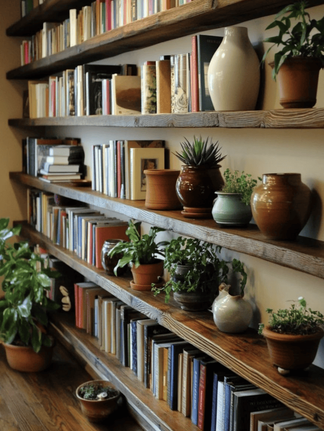Best wood for shelves: which hardwood should you choose for floating shelves?
- mybettershelf
- Oct 2
- 3 min read
Updated: 4 days ago
The choice of wood used for shelves determines their durability, appearance, and functionality—so it is worth choosing wisely. The surface of shelves is often subject to mechanical stress (loading and unloading books and decorations), so we recommend choosing hardwood: these are the species that score higher on the Janka hardness scale, making them less vulnerable to damage. (More about it: bellforestproducts.com)

Hardwood floating kitchen shelves
Popular hardwoods that are sure to be a hit
Oak– The eternal classic. Durable, easy to work with, responds well to oils and stains. Bleached/lightened oak has been particularly popular in recent years because it gives a clean, minimalist tone to the space – it is also a stable choice in kitchen trends. It offers excellent value for money, is accessible and is a genuine, high-quality solid wood.
American walnut – Elegant, darker character, ideal if you prefer deeper tones in your interior. Walnut often comes with chocolate brown hues and lighter sapwood, which gives it its characteristic contrast and premium feel. It is generally more expensive than oak, but in return it has an extremely refined appearance. (The sapwood is the outer part of the tree, which transports nutrients and water, while the heartwood is the inner part, where preservatives accumulate.)
Maple – Light, slightly yellowish tone, very homogeneous grain. It is extremely hard and wear-resistant, so it withstands everyday use well – a big favorite in Scandinavian and minimalist interiors.
Ash – Also light in color, it offers a clean aesthetic with its very even grain. Statically reliable, it is difficult to go wrong with an ash wood shelf, whether used with a darker stain or natural, adapted to the Scandinavian style.
Cherry – Warm, orange-red tone that deepens and develops a patina over time. It suits antique and classic interiors just as well as those looking for a modern, unique color scheme.
Why do we recommend hardwood for shelves?
Hardwood species such as oak, walnut, maple, ash, and cherry are much more resistant to dents and wear. Softwoods, such as pine and birch, are easily damaged and dented even by minor impacts, so they are not recommended for shelves in everyday use. In addition, they can bear less weight and lose their shape more quick
Design and custom solutions
You can choose virtually any of the above-mentioned wood types for mybettershelf floating shelves and drawer cabinets – we will make them for you in custom sizes with hidden wall mounts. You can fit them into modern, Scandinavian, classic or eclectic interiors: by fine-tuning the wood type and surface treatment, you can achieve exactly the atmosphere you have dreamed of.
You can request a clean, minimalist form, but if you are looking for a natural feel, you can also choose a live edge design. It is worth noting that the sapwood (outer layer) under the bark is usually lighter than the inner heartwood, so there may be a tonal transition at the edge of the board – this is one of the beauties of live edge.
What's more, if you want a special look, we also work with exotic wood species – in both solid and veneered finishes.
Which wood should you choose? Quick guide
"Best wood for shelves" for minimalists: maple, ash or whitened oak – light, uniform, very durable.
Timeless, trend-proof all-rounder: oak – natural, warm, can be beautifully bleached; unbeatable value for money.
Dark, elegant statement: American walnut – deep tone, premium character.
Warm, patinated atmosphere: cherry – expect it to darken over time.
In summary
The quality of the wood used for shelves and cabinets determines how long you can enjoy stylish and sturdy storage in your home. Hardwood – such as oak, walnut, maple, ash, or cherry – is the professional recommendation to ensure that your shelves remain resistant, durable, load-bearing, and always beautiful. The floating shelves and cabinets at mybettershelf can be custom-made to suit your needs – choose with confidence, request a quote, and create your own style!
Get more interior design tips by subscribing to our newsletter - so you can get every new content dispatched right to your inbox.
Photo: Pinterest, fargowoodworks, fussfreehome, decomagz









